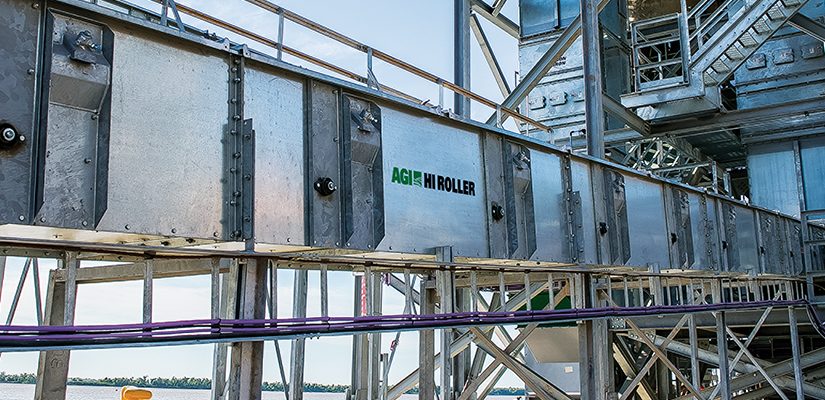The Hi Roller conveyor system was originally designed to solve a specific problem: grain dust.
When grain is conveyed, it releases dust into the surrounding area, which poses health risks to nearby workers and requires clean-up.
And while capturing the dust in an enclosed space reduces the amount emitted into the neighbouring area, it poses an explosion risk.
Enter Ag Growth International’s (AGI) High Roller conveyor, which contains dust and spillage while also reloading material back onto the carrying surface of the belt.
All of the bearings are isolated and there are no ledges in which build-up can gather. Instead, any spilled product or dust falls onto the return belt and is brought back to the tail section, where it is then diverted to the outer edges of the pulley that feature flippers to pass it back onto the belt.
Peter Forster, AGI’s Australia and New Zealand business manager, said the design has been refined over the decades.
“Hi Roller conveyors have been installed in more than 10,000 different applications across the world,” he said. “Around 90 per cent of grain terminals use them, as it’s a leading product that can be relied on to deliver.
“It’s most often used in mission-critical applications for high-use facilities, like mills and ports, where it works day in, day out.”
The conveyor’s self-cleaning abilities also makes it a good fit for port and out-loading facilities, which may need to move different grains or materials.
AGI acquired the Hi Roller product in December 2006, adding it to the global agricultural equipment manufacturer’s portfolio of brands.
One of these brands is CMC Industrial Electronics, which manufactures hazard-monitoring systems for industrial applications. CMC’s devices are used to perform temperature checks on bearings, and scan for belt misalignments and plugged discharge sensors.
Working in tandem with the Hi Roller conveyor, CMC’s low-voltage digital sensing platform can help monitor the shaft speed, bearing temperature, belt misalignment and vibration in harsh industrial environments.
Forster said the sensors and monitoring systems add additional reliability to the Hi Roller conveyors.
“CMC’s platform is often deployed alongside Hi Roller conveyors to provide automatic safety measures,” he said.
“If the belt’s take-up shaft slows by 10 per cent, an audible alarm will sound to alert operators. At 20 per cent, the feed will go into a controlled shut down, taking away the potential for human error.
“It will monitor for any blocked chutes, any increases in bearing temperature, belt slippage, and more. It connects to a programmable logic controller and can then send all that information to a phone or tablet in real time.
“If there’s a sudden failure, you will know about it straight away.”
Close collaboration between the brands means that all of AGI’s silos and support structures can easily integrate Hi Roller conveyors and monitoring systems. This attitude also applies to AGI’s dedicated support contractors, who are trained to diagnose and solve any issues across the company’s broad range of products and services.
Forster said the company plans to continue improving the Hi Roller design and has plans to develop further technologies to improve reliability even further.
“We have a lot of experience working with these products and know what to expect for all kinds of applications,” he said.
“AGI is a global company, which means our engineers have experience almost every condition around the planet.
“We can draw on that international expertise to ensure all of our equipment is fit for purpose and will last.”




